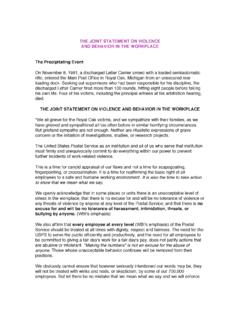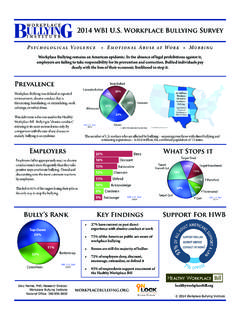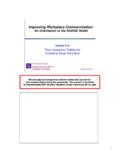Transcription of BULLYING POLICY - 02122013 - Workplace Bullying Institute
1 PIMA COUNTY, ARIZONA. BOARD OF SUPERVISORS POLICY . Subject: POLICY Number Page PREVENTING, IDENTIFYING AND ADDRESSING Workplace BULLYING . D 1 of 4. PURPOSE. This POLICY prohibits Workplace BULLYING by and against Pima County employees, applicants for employment and others in the Workplace environment, including members of the public. BULLYING may be directed toward an employee by a manager, co-worker, subordinate, appointing authority, elected official, vendor, contractor or member of the public. BULLYING conduct may be challenged even if the complaining party is not the intended target of the conduct.
2 POLICY . It is the POLICY of Pima County to provide a secure work environment for all employees that is free from BULLYING . I. DECLARATION. Pima County will not tolerate any behavior in the Workplace that constitutes BULLYING activity as defined in this POLICY . This POLICY also applies to use of the County email systems, computers, internet access, or any other County electronic communication systems or devices to engage in BULLYING activity. Any employee violating this POLICY will be subject to disciplinary action, up to and including dismissal. II. DEFINITION AND EXAMPLES.
3 A. Definition Workplace BULLYING is intentional behavior intended to create an abusive work environment for an employee or employees. BULLYING behavior is behavior in the Workplace that a reasonable person would find hostile, offensive, and not obviously related to an employer's legitimate business interests. B. Examples Workplace BULLYING can include group BULLYING , peer to peer BULLYING , supervisor to subordinate BULLYING , and situations when a subordinate employee subjects a supervisory-level employee to BULLYING . Examples of Workplace BULLYING include, but are not necessarily limited to, the following: 1.
4 BULLYING IN GENERAL. a. Use of disrespectful and devaluing language. b. Persistent or constant criticism in front of other persons (including co-workers, vendors, contractors or members of the public) for the purpose of humiliating another employee. c. Tampering with an employee's personal belongings or work equipment. Subject: POLICY Number Page PREVENTING, IDENTIFYING AND ADDRESSING Workplace BULLYING . D 2 of 4. d. Invasions of privacy, such as spying, stalking, rummaging through personal belongings (including unauthorized access of personal email and contents of personal cell phones and employee-owned Personal Digital Assistants).
5 Note: an employee has no expectation of privacy in any items of personal equipment attached to County network devices. e. Attempting to exploit an employee's known psychological or physical vulnerability (which may also be a violation of the Americans with Disabilities Act). f. Behavior or language that frightens, humiliates, belittles or degrades, including criticism that is delivered with yelling and screaming. 2. BULLYING BY SUPERVISOR. a. Making up arbitrary rules that only apply to the targeted employee. b. Assigning undesirable work as punishment. c.
6 Managing by threat and intimidation. d. Preventing access to opportunities. e. Being given tasks with unreasonable, impossible or constantly changing objectives and/or deadlines. f. Removing key areas of responsibility and/or replacing them with more trivial or unpleasant tasks for no business related reason. g. Denying access to necessary information, consultation, training, or resources. h. Withholding essential information or purposefully giving incorrect information. i. Constantly criticizing a subordinate employee's actions outside the scope of reasonable disciplinary efforts.
7 3. BULLYING BY CO-WORKERS (TO INCLUDE SUPERVISORS). In addition to the behaviors listed in number 2 above: a. Using confidential information to humiliate privately or publicly. b. Withholding information that affects an employee's performance. c. Intimidating an employee through inappropriate personal comments, disparaging opinions or criticism with no basis in fact. d. Taking credit for another employee's work. e. Repeatedly belittling a co-worker (whether publicly or privately). 4. BULLYING BY SABOTAGE. a. Falsely accusing an employee of making errors.
8 B. Ensuring failure of an employee's project by not performing required tasks, such as sign-offs, taking calls, working with collaborators, etc. c. Undermining or deliberately impeding an employee's work. 5. BULLYING BY SHUNNING. a. Isolating an employee from co-workers, in Workplace social events or physically. b. Launching a campaign not based on facts to provoke an employee to leave or be removed. c. Purposely excluding an employee from an essential meeting. d. Excluding employees from matters in which they would be expected to be included as part of the job.
9 Subject: POLICY Number Page PREVENTING, IDENTIFYING AND ADDRESSING Workplace BULLYING . D 3 of 4. III. PROCEDURE. A. Reporting 1. Targets: When an employee believes that he or she is the target of behavior that may satisfy the definition of Workplace BULLYING (as defined herein), the employee must report any and all incidents immediately to a supervisory level employee, to include their supervisor, division manager, appointing authority, elected official, the supervisor of the alleged bully, or to Human Resources Employment Rights. Employees who believe they are the target of BULLYING are not required to confront the alleged bully.
10 2. Witnesses: When an employee has witnessed or was made aware of behavior that may satisfy the definition of Workplace BULLYING (as defined herein), the employee must report any and all incidents immediately to their supervisor, division manager, appointing authority, elected official, the supervisor of the alleged bully, or to Human Resources Employment Rights. 3. Supervisors: When a supervisory level employee is notified about possible Workplace BULLYING behavior (as defined herein), the supervisor must immediately notify Human Resources. 4. Human Resources: Employees always have the right to report potential BULLYING activity directly to Human Resources.








